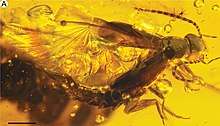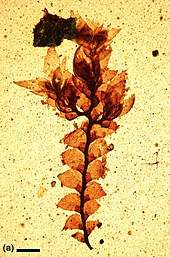Burmese amber
Burmese amber, also known as Burmite or Kachin amber, is amber from the Hukawng Valley in northern Myanmar. The amber is dated to around 99 million years old, during the earliest part of the Cenomanian age of the Late Cretaceous. The amber is of significant palaeontological interest due to the diversity of flora and fauna contained as inclusions, particularly arthropods including insects and arachnids but also birds, lizards, snakes, frogs and fragmentary dinosaur remains. The amber has been known and commercially exploited since the first century AD, and has been known to science since the mid-nineteenth century. Research on the deposit has attracted controversy due to its role in funding internal conflict in Myanmar and hazardous working conditions in the mines where it is collected.

Geological context, depositional environment and age
.jpg)
The amber is found within the Hukawng Basin, a large Mesozoic-Cenozoic sedimentary basin within northern Myanmar. The strata have undergone folding and faulting. The basin is considered to be a part of the West Burma Block or Burma Terrane, which has a debated tectonic history. The block was part of Gondwana during at least the Early Paleozoic, but the timing of rifting is very uncertain, with estimates ranging from the Devonian to Early Cretaceous. It is also disputed whether the block had accreted onto the Asian continental margin by the time of the amber deposition.[1] Some members of the flora and fauna have Gondwanan affinities[2] A recent paleomagnetic reconstruction finds that the Burma Terrane formed an island land mass in the Tethys Ocean during the Mid Creaceous at a latitude around 5-10 degrees south of the equator.[3]
At Noije Bum, located on a ridge, amber is found within fine grained clastic rocks, typically medium to greyish green in colour, resulting from the constituent grains being black, yellow, grey and light green. The fine grained rocks are primarily fine to very fine grained sandstone, with beds of silt and shale and laterally persistent thin (1–2 mm thick) coal horizons. Massive micritic limestone interbeds of 6-8 centimetre thickness, often containing coalified plant material also occur. This facies association is typically around 1 metre thick and typically thinly bedded and laminated. Associated with the fine grained facies is a set of medium facies primarily consisting of medium to fine grained sandstones also containing thin beds of siltstone, shale and conglomerate, alongside a persistent conglomerate horizon. A specimen of the ammonite Mortoniceras has been found in a sandstone bed 2 metres above the amber horizon, alongside indeterminate gastropods and bivalves.[4] Lead-uranium dating of zircon crystals of volcanic clasts within the amber bearing horizons has given a maximum age of 98.79 ± 0.62 Ma, making the deposit earliest Cenomanian in age.[5] Unpublished data by Wang Bo on other layers suggests an age range of deposition of at least 5 million years.[6] The amber does not appear to have undergone significant transport since hardening or be redeposited. The strata at the site are younging upwards, striking north north-east and dipping 50-70 degrees E and SE north of the ridge and striking between south south-east and south-east and dipping 35-60 degrees south of it, suggesting the site is on the northwest limb of a syncline plunging to the northeast. A minor fault with a conspicuous gouge zone was noted as present, though it appeared to have no significant displacement.[4]
Paleoenvironment

The Burmese amber paleoforest is considered to have been an estuarian coastal tropical rainforest where resin was subsequently transported into a brackish shallow marine environment. The presence of troglobitic nocticolid cockroaches suggests the nearby presence of caves.[7] The shell of a dead juvenile Puzosia (Bhimaites) species ammonite, four marine gastropod shells (including Mathilda) and littoral or supralittoral isopods entombed in a piece of amber with shell sand,[8] along with growth of Isocrinid crinoids, corals and oysters on the surface of some pieces indicate tidal zone conditions.[9] Additionally pholadid bivalve borings into amber specimens along with at least one pholadid which became trapped show that the resin was still fresh and unhardened when it was being moved into the tidal areas.[10]

The amber itself is primarily disc-shaped and flattened along the bedding plane, and is typically reddish brown, with the colour varying from shades of yellow to red. The opacity of the amber is variable from clear to opaque. Many amber pieces have thin calcite veins that are typically less than a millimetre thick, but are up to 4–5 mm (0.16–0.20 in) wide. The number and proportion of veins in a piece of amber varies significantly, in some pieces veins are virtually absent, while others are described as being "packed with veinlets"[4] The amber is considered to be of coniferous origin, with a likely araucarian source tree, based on spectroscopic analysis and wood fragment inclusions,[11] though a pine origin has also been suggested.[12]
Fauna and flora
The list of taxa is extraordinarily diverse, with over 42 classes, 108 orders, 569 families, 1017 genera and 1379 species described as of the end of 2019, with over 300 species described in 2019 alone, the vast majority (94%) of which are arthropods. A complete list of taxa up until the end of 2018 can be found in Ross 2018[13] And a supplement covering most of 2019 can be found in Ross 2019b.[14] For the sake of brevity, a complete list of taxa is not given here, and the classification is mostly at family level. For a more complete list of taxa, see Paleobiota of Burmese amber.
Invertebrates
Well over 1000 species of invertebrates are known from the deposit, including, notably the oldest members of Palpigradi (Electrokoenenia)[15] and Schizomida (Mesozomus)[16] the oldest Velvet worm (Cretoperipatus)[17] and the only known fossil members of Mesothelae and Ricinulei since the Paleozoic. Chimerarachne is a unique stem spider still possessing a tail, with similar forms only known from the Paleozoic.
Arachnids
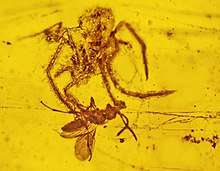
Araneae
Forty-four families of spiders are known from the Burmese amber, including: Archaeidae, †Burmadictynidae, †Burmascutidae, †Burmathelidae, Clubionidae, Corinnidae, †Cretaceothelidae, Deinopidae, Dipluridae, †Eopsilodercidae, †Fossilcalcaridae, Hersiliidae, Hexathelidae, †Lagonomegopidae, Leptonetidae, Liphistiidae, †Micropalpimanidae, †Mongolarachnidae, Mysmenidae, Ochyroceratidae, Oecobiidae, Oonopidae, Oxyopidae, Palpimanidae, †Parvithelidae, Pholcidae, †Pholcochyroceridae, †Plumorsolidae, †Praearaneidae, †Praeterleptonetidae, Psechridae, Psilodercidae, Salticidae, Segestriidae, Telemidae, Tetrablemmidae, Tetragnathidae, Theridiosomatidae, Theridiidae, Thomisidae, Uloboridae and †Vetiaroridae.
Acariformes
Twenty families of acariformes ae known from the Burmese amber, including: Anystidae, Archaeorchestidae, Bdellidae, Caeculidae, Cheyletidae, Enantioppiidae, Eremaeidae, Erythraeidae, Eupodidae, Gymnodamaeidae, Malaconothridae, Microtrombidiidae, Neoliodidae, Oribatellidae, Oribotritiidae, Resinacaridae, Smarididae, Trombellidae, Trombidiidae and Tuckerellidae.
Opiliones
Five families of opiliones are known from the Burmese amber, including: Epedanidae, †Halithersidae, †Monooculricinuleidae, Sclerosomatidae and Stylocellidae.
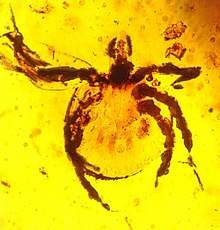
Pseudoscorpiones
Twelve families of pseudoscorpions are known from the Burmese amber, including: Atemnidae, Cheiridiidae, Cheliferidae, Chernetidae, Chthoniidae, Feaellidae, Garypinidae, Hyidae Ideoroncidae, Neobisiidae, Pseudocheiridiidae and Withiidae.
Scorpiones
Seven families of scorpions are known from the Burmese amber, including: Buthidae, Chaerilidae, †Chaerilobuthidae, †Palaeoburmesebuthidae, †Palaeoeuscorpiidae, †Palaeotrilineatidae and †Sucinolourencoidae.
Parasitiformes
Five families of parasitiformes are known from the Burmese amber, including: Argasidae, †Deinocrotonidae, Ixodidae, Opilioacaridae and Polyaspididae.
Schizomida
One genus of schizomida is known from the Burmese amber: Mesozomus, which belongs to Hubbardiidae
Palpigradi
One genus of palpigradi is known: Electrokoenenia, which belongs to Eukoeneniidae
Amblypygi
One genus of Amblypygi is known: Kronocharon, which does not belong to any extant family.
Solfugae
One genus of camel spider is known: Cushingia, which does not belong to any extant family.
Thelyphonida
Two genera of whip scorpion are known: Mesothelyphonus, which belongs to Thelyphonidae and Burmathelyphonia, which does not belong to any extant family.
Ricinulei
Three genera of Ricinulei are known: Hirsutisoma, ?Poliochera (an otherwise Carboniferous taxon) and Primoricinuleus, none of which belong to extant families
Myriapoda

Fifteen families of Myriapods are known, including: Anthroleucosomatidae, Tingupidae, Glomeridellidae, Andrognathidae, Paradoxosomatidae, Polydesmidae, Polyxenidae, Synxenidae, Polyzoniidae, Siphoniulidae, Siphonophoridae, Siphonorhinidae, Zephroniidae, Cambalidae, Scolopendrellidae and †Burmanopetalidae.
Entognatha
Eight families of Entognathans are known, including: Campodeidae, Japygidae, Isotomidae, †Praentomobryidae, Tomoceridae, Neanuridae, Odontellidae and Sminthuridae.
Insects
Incertae cedis
A species of the enigmatic long legged insect Chresmoda is known.[18] As is the lice-like parasite Mesophthirus.[19]
Archaeognatha
Two families of archaeognathans are known from the Burmese amber: Machilidae and Meinertellidae
Zygentoma
One family of Zygentoman is known: Lepismatidae
Ephemeroptera
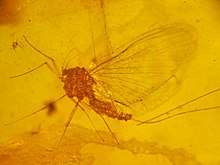
Seven families of mayfly are known: †Australiphemeridae, Baetidae, Ephemeridae, Heptageniidae, †Hexagenitidae, Isonychiidae, Prosopistomatidae.
Odonata
Twenty families of odonatan are known from the Burmese amber, including: Aeshnidae, †Araripegomphidae, †Burmacoenagrionidae, †Burmaeshnidae, †Burmagomphidae, †Burmaphlebiidae, Calopterygidae, Coenagrionidae, Dysagrionidae, Gomphaeschnidae, Gomphidae, Hemiphlebiidae, Libellulidae, Lindeniidae, Megapodagrionidae, †Mesomegaloprepidae, †Paracoryphagrionidae, Perilestidae, Platycnemididae, Platystictidae.
Hymenopterans
Over fifty families of hymenopterans have been described beginning with the papers of Cockerell who described a group of Bethylidae and Aulacidae species between 1917–1920. The monotypic family Melittosphecidae is only known from the Burmese amber species Melittosphex burmensis and eight species belonging to Aptenoperissus of the monotypic family Aptenoperissidae are also known. Originally described as an Aneuretinae ant Burmomyrma rossi was moved to the extinct Chrysidoidea family Falsiformicidae.[20] A number of Formicidae species known, belonging to Baikuris (indet) Camelomecia janovitzi, Ceratomyrmex ellenbergeri, 11 species of Gerontoformica, 3 species of Haidomyrmex, Linguamyrmex vladi, 2 species of Zigrasimecia, Dhagnathos autokrator, Chonidris insolita, Aquilomyrmex huangi, Protoceratomyrmex revelatus and Linguamyrmex brevicornis. Other families include Ampulicidae, Braconidae, Cephidae, Ceraphronidae, Chalcididae, Chrysididae, Crabronidae, Diapriidae, Dryinidae, Embolemidae, Evaniidae, Gasteruptiidae, Heloridae, Ichneumonidae, Megalyridae, Megaspilidae, Mymaridae, Mymarommatidae, Pelecinidae, Platygastridae, Rhopalosomatidae. Rotoitidae, Sapygidae, Scelionidae, Sclerogibbidae, Scolebythidae, Sepulcidae, Sierolomorphidae, Siricidae, Sphecidae, Stephanidae, Tiphiidae, Vespidae, Xiphydriidae, †Aptenoperissidae, †Bryopompilidae, †Burmusculidae, †Chrysobythidae, †Dipterommatidae, †Diversinitidae, †Falsiformicidae, †Gallorommatidae, †Maimetshidae, †Myanmarinidae, †Othniodellithidae, †Praeaulacidae, †Proterosceliopsidae, †Serphitidae, †Spathiopterygidae, †Syspastoxyelidae and several incertae cedis taxa.
Dipterans
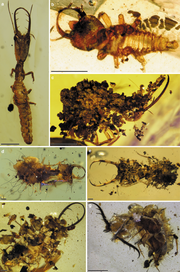
Forty-seven families of dipterans are known from the Burmese amber, including: Acroceridae, Anisopodidae, Apsilocephalidae, Apystomyiidae, Asilidae, Atelestidae, Blephariceridae, Bombyliidae, Cecidomyiidae, Ceratopogonidae, Chaoboridae, Chironomidae, Corethrellidae, Culicidae, Diadocidiidae, Dolichopodidae, Empididae, Hybotidae, Keroplatidae, Limoniidae, Lygistorrhinidae, Mycetophilidae, Mythicomyiidae, Nemestrinidae, Phoridae, Pipunculidae, Platypezidae, Psychodidae, Ptychopteridae, Rachiceridae, Rhagionidae, Scatopsidae, Sciaridae, Stratiomyidae, Tabanidae, Tanyderidae, Tipulidae, Valeseguyidae, Xylomyidae, †Cascopleciidae, †Chimeromyiidae, †Eremochaetidae, †Eucaudomyiidae, †Mysteromyiidae, †Rhagionemestriidae, †Tethepomyiidae, †Zhangsolvidae and several incertae cedis taxa.
Coleopterans
Eighty-nine families of coleopterans are known from the Burmese amber, including: Aderidae, Anthicidae, Anthribidae, †Apotomouridae, Belidae, Boganiidae, Bostrichidae, Brachypsectridae, Buprestidae, Cantharidae, Carabidae, Caridae, Cerambycidae, Cerophytidae, Cerylonidae, Chrysomelidae, Ciidae, Clambidae, Cleridae, Cucujidae, Cupedidae, Curculionidae, Cyclaxyridae, Dascillidae, Dermestidae, Drilidae, Dytiscidae, Elateridae, Elmidae, Endomychidae, Eucinetidae, Eucnemidae, Geotrupidae, Glaresidae, Gyrinidae, Histeridae, Hybosoridae, Hydraenidae, Hydrophilidae, Ithyceridae, Jacobsoniidae, Kateretidae, Laemophloeidae, Lampyridae, Latridiidae, Leiodidae, Lepiceridae, Lucanidae, Lycidae, Lymexylidae, Melandryidae, Meloidae, Melyridae, †Mesophyletidae, Monotomidae, Mordellidae, Nemonychidae, Nitidulidae, Oedemeridae, Ommatidae, Passalidae, †Parandrexidae, †Passalopalpidae, Passandridae, Prostomidae, Psephenidae, Ptiliidae, Ptinidae, Ptilodactylidae, Ripiphoridae, Rhysodidae, Salpingidae, Scarabaeidae, Scirtidae, Scraptiidae, Silphidae, Silvanidae, Smicripidae, Sphaeriusidae, Staphylinidae, Tenebrionidae, Tetratomidae, Thanerocleridae, Throscidae, Trogidae, Trogossitidae and Zopheridae.
Neuroptera
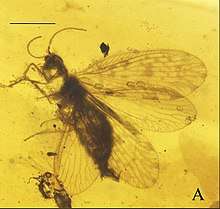
Twenty-one families of neuropterans are known from the Burmese amber, including: Ascalaphidae, †Babinskaiidae, Berothidae, Chrysopidae, Coniopterygidae, †Corydasialidae, Dilaridae, †Dipteromantispidae, Hemerobiidae, Ithonidae, Kalligrammatidae, Mantispidae, †Mesochrysopidae, Myrmeleontidae, Nemopteridae, Nevrorthidae, Nymphidae, Osmylidae, Psychopsidae, Rachiberothidae, Sisyridae and several incertae cedis taxa.
Hemiptera
Sixty five families of hemipterans are known from the Burmese amber, including: Achilidae, †Albicoccidae, Aleyrodidae, Aphrophoridae, Aradidae, †Burmacoccidae, †Burmitaphidae, Callaphididae, Cercopidae, Cicadellidae, Cicadidae, Cimicidae, Cixiidae, Coccidae, Coreidae, Cydnidae, Dictyopharidae, Dipsocoridae, †Dorytocidae, Enicocephalidae, Fulgoridae, Gelastocoridae, Gerridae, †Hodgsonicoccidae, Hydrometridae, Issidae, †Jubisentidae, †Juraphididae, Kinnaridae, †Kozariidae, †Lalacidae, Leptopodidae, †Liadopsyllidae, Margarodidae, Matsucoccidae, †Mimarachnidae, †Minlagerrontidae, Miridae, Monophlebidae, Naucoridae, Ochteridae, Ortheziidae,†Palaeoleptidae, †Parvaverrucosidae, †Perforissidae, †Protopsyllidiidae, †Procercopidae, Pseudococcidae, Reduvidae, Schizopteridae, †Sinoalidae, †Tajmyraphididae, Tettigarctidae, Tingidae, Tropiduchidae, Velocipedidae, Veliidae, †Weitschatidae, Xylococcidae, †Yetkhatidae, Nabidae, †Neazoniidae and several incertae cedis taxa.
Dictyoptera
Twenty families of dictyopterans are known from the Burmese amber, including: Blaberidae, †Blattulidae, Blattidae, †Caloblattinidae, Corydiidae, Ectobiidae, †Olidae, †Liberiblattinidae, †Alienopteridae, †Manipulatoridae †Umenocoleidae , Nocticolidae, †Pabuonqedidae Termites (†Archeorhinotermitidae, Hodotermitidae, Termitidae and Mastotermitidae) and mantid Burmantis.
Mecoptera
Five families of mecopteran are known, including: Bittacidae, Meropeidae, Mesopanorpodidae, †Pseudopolycentropodidae and †Dualulidae.
Psocoptera
Nine families of psocopteran are known, including: †Archaeatropidae, Compsocidae, Liposcelididae, Manicapsocidae, Pachytroctidae, Prionoglarididae, Psyllipsocidae, Sphaeropsocidae and Trogiidae.
Orthoptera
Six families of orthopteran are known, including: †Elcanidae, Gryllidae, Mogoplistidae, Tetrigidae, Tettigoniidae and Tridactylidae
Trichoptera
Eight families of trichopteran are known, including: Calamoceratidae, †Dysoneuridae, Helicopsychidae, Hydroptilidae, Odontoceridae, Philopotamidae, Polycentropodidae and Psychomyiidae.
Dermaptera
Five families of dermapteran are known, including: Anisolabididae, Diplatyidae, Labiduridae and Pygidicranidae.
Embioptera
Four families of embiopteran are known, including: Clothodidae, Oligotomidae, Notoligotomidae and †Sorellembiidae.
Notoptera
One species of notopteran is known, a nymph ice crawler (Grylloblattidae) Sylvalitoralis cheni.[21]
Strepsiptera
Four families of strepsipteran are known, including: †Cretostylopidae, †Kinzelbachillidae, †Mengeidae, †Phthanoxenidae
Lepidoptera
Four families of lepidopteran are known, including: Douglasiidae, Gelechiidae, Gracillariidae and Micropterigidae.
Megaloptera
One species of megalopteran is known, Haplosialodes liui of the family Sialidae.
Phasmatodea
Four families of phasmatodean are known: †Archipseudophasmatidae, Phasmatidae. †Pterophasmatidae and Timematidae

Thysanoptera
Four families of thrips are known, including: Aeolothripidae, †Rohrthripidae, Thripidae and Stenurothripidae.

Plecoptera
Two families of stoneflies are known, Perlidae and †Petroperlidae.
Raphidioptera
One family of Raphidiopteran is known, †Mesoraphidiidae.
†Tarachoptera
One family of Tarachopteran is known: †Tarachocelidae
Zoraptera
Multiple species of Zorotypus and the monotypic genus Xenozorotypus are known.
Nematoda
Five families of nematodes are known, including: Cosmocercidae, Heterorhabditidae, Mermithidae, Thelastomatidae, Aphelenchoididae
Nematomorpha
One genus of nematomorph is known: Cretachordodes (Chordodidae, Gordioidea)
Mollusca
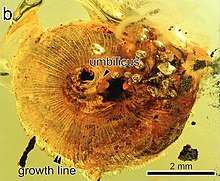
Aside from the previously mentioned ammonites and marine gastropod shells, Seven families of terrestrial gastropod are known: Diplommatinidae, Pupinidae, Achatinidae, Punctidae, Valloniidae, Assimineidae and Cyclophoridae[22][23][24]
Vertebrates
_fig._1.png)
While the deposit is well known for invertebrate inclusions, some vertebrate inclusions have been found as well. One of the more notable discoveries was a well preserved theropod dinosaur tail, with preserved feathers.[25] As well as fossils of enantiornithine birds including juveniles[26][27] and partial wings and preserved feet,[28][29][30][31] including a diagnostic taxon, Elektorornis.[32] A complete skull of the bizarre avialan or lizard Oculudentavis is known.[33] Electrorana is a well preserved frog known from the amber.[34] Other notable specimens include an embryonic snake.[35] Several species of lizard were described from the deposit including a gecko with preserved toe pads (Cretaceogekko).[36][37] One of the specimens was initially described to be a chamelonid, actually turned out to be an albanerpetonid amphibian.[38]
Flora
Angiosperms
Eleven species of Angiosperm are known in nine genera, including members of Cornaceae, Cunoniaceae, Lauraceae, ?Monimiaceae and Laurales incertae cedis. Poales incertae cedis and Angiosperm incertae cedis.
Bryopsida
Two genera of Bryopsida in the separate orders Dicranales and Hypnodendrales
Jungermanniopsida
Three families of Jungermanniopsida are known, Frullaniaceae, Lepidolaeanaceae, Radulaceae.
Pinophyta
Two families of Pinopsida are known: Araucariaceae and Cupressaceae including Metasequoia.
Pteridopsida
Four families of Pteridopsidan are known: Cystodiaceae, Dennstaedtiaceae, Lindsaeaceae, Pteridaceae and several genera of Polypodiales incertae cedis.
Amoebozoa
Myxogastria
Sporocarps of extant myxogastrid slime mould genus Stemonitis are known.[39]
Dictyostelia
A possible dictyostelid Paleoplastes burmanica has been described.[40]
History
The amber is apparently referred to in ancient Chinese sources as originating from Yunnan Province as early as the first century AD according to the Book of the Later Han and trade with China had been ongoing for centuries. It was first mentioned in European sources by the Jesuit Priest Álvaro Semedo who visited China in 1613, it was described as being "digged out of mines, and sometimes in great pieces, it is redder than our amber though not so cleane".[41] The locality itself has been known to European explorers since the 1800s with visitation to the Hukawng Valley by Simon Fraser Hannay in 1836–1837.[42][43] At that time the principle products of the valley mines were salt, gold, and amber, with the majority of gold and amber being bought by Chinese traders. Hannay visited the amber mines themselves on March 21, 1836, and he noted that the last three miles to the mines were marked with numerous abandoned pits, up to 15 ft (4.6 m) in depth, where amber had been dug in the past. The mining had moved over the hill to a series of 10 pits but no visible amber was seen, suggesting that miners possibly hid the amber found that day before the party arrived. Mining was being performed manually at the time through the use of sharpened bamboo rods and small wooden shovels. Finer pieces of amber were recovered from the deeper pits, with clear yellow being recovered from depths of 40 ft (12 m) The recovered amber was bought with silver or often exchanged for jackets, hats, copper pots, or opium among other goods. mixed and lower quality amber was sold from around 1/ ticals to 4 rupees per seer. Pieces that were considered high quality or fit or use as ornamentation were described as expensive and price varied depending on clarity and color. Women of the valley were noted to wear amber earrings as part of their jewelry.[42] In 1885 the Konbaung dynasty was annexed to the British Raj and a survey of the area was conducted by Dr. Fritz Noetling on behalf of the Geological Survey of India.[41] The final research before Burmese independence in 1947 was conducted by Dr. H.L. Chhibber in 1934, who provided the most detailed description of Burmite occurrences.[41]
History of research
The first research on the inclusions in the Burmese amber was published in 1916 by Theodore Dru Alison Cockerell, who initially concluded that the amber was Miocene in age. However, he subsequently noted the archaic nature of the insects, and concluded that the amber must be older.[41]
Modern exploitation and controversy
A small Canadian mining firm controlled the deposit from the mid 1990s to c. 2000, though the history of exploitation during the 2000s and early 2010s is obscure. The deposit is apparently currently controlled by the Burmese Military, which took over the mines in June 2017 from the Kachin Independence Army.[44] The working conditions at the mines have been described as extremely unsafe, down 100 m (330 ft) deep pits barely wide enough to crawl through, with no accident compensation. The presence of calcite veins are a major factor in determining the gem quality of pieces, with pieces with a large number of veins having significantly lower value.[4] Most of the Amber from the mines appears to be smuggled into China to be sold, and sales of amber have been alleged to help fund the Kachin conflict by various news organisations in 2019.[6][45][46] Interest in this discussion rose in 2020 after the highly publicised description of Oculudentavis, which made the cover of Nature.[47] On April 21st, 2020 the Society of Vertebrate Paleontology (SVP) published a letter of recommendation to journal editors discouraging them from publishing studies on burmese amber material.[48] On April 23rd, 2020 Acta Palaeontologica Polonica stated that it would not accept papers on Burmese amber material collected from 2017 onwards, after the Burmese millitary took control of the deposit, requiring "certification or other demonstrable evidence, that they were acquired before the date both legally and ethically".[49] On May 13th, 2020, the Journal of Systematic Palaeontology published an editorial stating that it would no longer consider papers based whole or in part on Burmese amber material, regardless of whether in historic collections or not.[50]
Other Myanmar ambers
Other deposits of amber are known from several regions in Myanmar, with noted deposits in the Shwebo District of the Sagaing Region, from the Pakokku and Thayet districts of Magway Region and the Bago District of the Bago Region.[51][43] Unlike the Hukawng deposit, none of the other sources have produce notable quantities of amber. A 2018 study on an amber deposit from Tilin in central Myanmar indicated that deposit to be 27 million years younger than the Hukawng deposit, dating to approximately 72 million years old, placing it in the latest Campanian age. Within a number of arthropod specimens were described though much more poorly preserved than specimens in the Hukawng amber. These include members of Hymenoptera (Braconidae, Diapriidae, Scelionidae) Diptera (Ceratopogonidae, Chironomidae) Dictyoptera (Blattaria, Mantodea) planthoppers, Berothidae and bark lice (Lepidopsocidae) as well as extant ant subfamilies Dolichoderinae and tentatively Ponerinae, as well as fragments of moss.[52]
References
- Metcalfe, Ian (June 2017). "Tectonic evolution of Sundaland". Bulletin of the Geological Society of Malaysia. 63: 27–60. doi:10.7186/bgsm63201702.
- Poinar, George (2018-03-09). "Burmese amber: evidence of Gondwanan origin and Cretaceous dispersion". Historical Biology: 1–6. doi:10.1080/08912963.2018.1446531. ISSN 0891-2963.
- Westerweel, Jan; Roperch, Pierrick; Licht, Alexis; Dupont-Nivet, G.; Win, Zaw; Poblete, Fernando; Ruffet, Gilles; Swe, Hnin; Thi, Myat; Aung, Day (2019-10-01). "Burma Terrane part of the Trans-Tethyan Arc during collision with India according to palaeomagnetic data". Nature Geoscience. 12 (10): 863–868. Bibcode:2019NatGe..12..863W. doi:10.1038/s41561-019-0443-2. PMC 6774779. PMID 31579400.
- Cruickshank, R.D; Ko, Ko (February 2003). "Geology of an amber locality in the Hukawng Valley, Northern Myanmar". Journal of Asian Earth Sciences. 21 (5): 441–455. Bibcode:2003JAESc..21..441C. doi:10.1016/S1367-9120(02)00044-5.
- Shi, Guanghai; Grimaldi, David A.; Harlow, George E.; Wang, Jing; Wang, Jun; Yang, Mengchu; Lei, Weiyan; Li, Qiuli; Li, Xianhua (October 2012). "Age constraint on Burmese amber based on U–Pb dating of zircons". Cretaceous Research. 37: 155–163. doi:10.1016/j.cretres.2012.03.014.
- Sokol, Joshua (2019-05-23). "Fossils in Burmese amber offer an exquisite view of dinosaur times—and an ethical minefield". Science. doi:10.1126/science.aay1187. ISSN 0036-8075.
- Sendi, Hemen; Vršanský, Peter; Podstrelená, Lenka; Hinkelman, Jan; Kúdelová, Tatiana; Kúdela, Matúš; Vidlička, Ľubomír; Ren, Xiaoyin; Quicke, Donald L.J. (February 2020). "Nocticolid cockroaches are the only known dinosaur age cave survivors". Gondwana Research. 82: 288–298. Bibcode:2020GondR..82..288S. doi:10.1016/j.gr.2020.01.002.
- Yu, T.; Kelly, R.; Mu, L; Ross, A.; Kennedy, J.; Broly, P.; Xia, F.; Zhang, H.; Wang, B.; Dilcher, D. (2019-06-04). "An ammonite trapped in Burmese amber". Proceedings of the National Academy of Sciences. 116 (23): 11345–11350. doi:10.1073/pnas.1821292116. ISSN 0027-8424. PMC 6561253. PMID 31085633.
- Mao, Y.; Liang, K.; Su, Y.; Li, J.; Rao, X.; Zhang, H.; Xia, F.; Fu, Y.; Cai, C.; Huang, D. (2018-12-28). "Various amberground marine animals on Burmese amber with discussions on its age". Palaeoentomology. 1 (1): 91. doi:10.11646/palaeoentomology.1.1.11. ISSN 2624-2834.
- Smith, Ru D. A.; Ross, Andrew J. (January 2018). "Amberground pholadid bivalve borings and inclusions in Burmese amber: implications for proximity of resin-producing forests to brackish waters, and the age of the amber". Earth and Environmental Science Transactions of the Royal Society of Edinburgh. 107 (2–3): 239–247. doi:10.1017/S1755691017000287. ISSN 1755-6910.
- Poinar, G.; Lambert, J.B.; Wu, Y. (2007-08-10). "Araucarian source of fossiliferous Burmese amber: Spectroscopic and anatomical evidence". Journal of the Botanical Research Institute of Texas. 1: 449–455.
- Dutta, S.; Mallick, M.; Kumar, K.; Mann, U.; Greenwood, P. F. (January 2011). "Terpenoid composition and botanical affinity of Cretaceous resins from India and Myanmar". International Journal of Coal Geology. 85 (1): 49–55. doi:10.1016/j.coal.2010.09.006.
- Ross, A.J. 2018. Burmese (Myanmar) amber taxa, on-line checklist v.2018.2 104pp
- Ross, A.J. 2019b. Burmese (Myanmar) amber taxa, on-line supplement v.2019.2. 33pp.
- Engel, Michael S.; Breitkreuz, Laura C. V.; Cai, Chenyang; Alvarado, Mabel; Azar, Dany; Huang, Diying (15 February 2016). "The first Mesozoic microwhip scorpion (Palpigradi): a new genus and species in mid-Cretaceous amber from Myanmar". The Science of Nature. 103 (3–4): 19. Bibcode:2016SciNa.103...19E. doi:10.1007/s00114-016-1345-4. PMID 26879963.
- Müller, Sandro P.; Dunlop, Jason A.; Kotthoff, Ulrich; Hammel, Jörg U.; Harms, Danilo (February 2020). "The oldest short-tailed whipscorpion (Schizomida): A new genus and species from the Upper Cretaceous amber of northern Myanmar". Cretaceous Research. 106: 104227. doi:10.1016/j.cretres.2019.104227.
- Oliveira, I.; Bai, M.; Jahn, H.; Gross, V.; Martin, C.; Hammel, J. U.; Zhang, W.; Mayer, G. (2016). "Earliest Onychophoran in Amber Reveals Gondwanan Migration Patterns". Current Biology. 26 (19): 2594–2601. doi:10.1016/j.cub.2016.07.023. PMID 27693140.
- W. W. Zhang and S. Q. Ge. 2017. Systematic paleontology, in A new species of Chresmodidae from Mid-Cretaceous amber discovered in Myanmar. Zoological Systematics 42:243-247
- Gao, Taiping; Yin, Xiangchu; Shih, Chungkun; Rasnitsyn, Alexandr P.; Xu, Xing; Chen, Sha; Wang, Chen; Ren, Dong (December 2019). "New insects feeding on dinosaur feathers in mid-Cretaceous amber". Nature Communications. 10 (1): 5424. Bibcode:2019NatCo..10.5424G. doi:10.1038/s41467-019-13516-4. ISSN 2041-1723. PMC 6904634. PMID 31822675.
- Lucena, D. A. A.; Melo, G. A. R. (2018). "Chrysidid wasps (Hymenoptera: Chrysididae) from Cretaceous Burmese amber: Phylogenetic affinities and classification". Cretaceous Research. 89: 279–291. doi:10.1016/j.cretres.2018.03.018.
- Weiwei Zhang, Mingxia Guo; Weiwei Zhang, Mingxia Guo. "A new species of ice crawlers from Burmese amber (Insecta: Grylloblattodea)". Zoological Systematics. 41 (3): 327–331. doi:10.11865/zs.201637. ISSN 2095-6827. S2CID 134290216.
- Yu, Tingting; Wang, Bo; Pan, Huazhang (October 2018). "New terrestrial gastropods from mid-Cretaceous Burmese amber". Cretaceous Research. 90: 254–258. doi:10.1016/j.cretres.2018.04.015.
- Hirano, Takahiro; Asato, Kaito; Yamamoto, Shûhei; Takahashi, Yui; Chiba, Satoshi (December 2019). "Cretaceous amber fossils highlight the evolutionary history and morphological conservatism of land snails". Scientific Reports. 9 (1): 15886. Bibcode:2019NatSR...915886H. doi:10.1038/s41598-019-51840-3. ISSN 2045-2322. PMC 6828811. PMID 31685840.
- Bullis, David A.; Herhold, Hollister W.; Czekanski-Moir, Jesse E.; Grimaldi, David A.; Rundell, Rebecca J. (March 2020). "Diverse new tropical land snail species from mid-Cretaceous Burmese amber (Mollusca: Gastropoda: Cyclophoroidea, Assimineidae)". Cretaceous Research. 107: 104267. doi:10.1016/j.cretres.2019.104267.
- Xing, Lida; McKellar, Ryan C.; Xu, Xing; Li, Gang; Bai, Ming; Persons, W. Scott; Miyashita, Tetsuto; Benton, Michael J.; Zhang, Jianping; Wolfe, Alexander P.; Yi, Qiru (December 2016). "A Feathered Dinosaur Tail with Primitive Plumage Trapped in Mid-Cretaceous Amber". Current Biology. 26 (24): 3352–3360. doi:10.1016/j.cub.2016.10.008. PMID 27939315.
- Xing, Lida; O'Connor, Jingmai K.; McKellar, Ryan C.; Chiappe, Luis M.; Tseng, Kuowei; Li, Gang; Bai, Ming (September 2017). "A mid-Cretaceous enantiornithine (Aves) hatchling preserved in Burmese amber with unusual plumage". Gondwana Research. 49: 264–277. Bibcode:2017GondR..49..264X. doi:10.1016/j.gr.2017.06.001.
- Xing, Lida; O'Connor, Jingmai K.; McKellar, Ryan C.; Chiappe, Luis M.; Bai, Ming; Tseng, Kuowei; Zhang, Jie; Yang, Haidong; Fang, Jun; Li, Gang (February 2018). "A flattened enantiornithine in mid-Cretaceous Burmese amber: morphology and preservation". Science Bulletin. 63 (4): 235–243. doi:10.1016/j.scib.2018.01.019.
- Xing, Lida; McKellar, Ryan C.; O’Connor, Jingmai K.; Bai, Ming; Tseng, Kuowei; Chiappe, Luis M. (2019-01-30). "A fully feathered enantiornithine foot and wing fragment preserved in mid-Cretaceous Burmese amber". Scientific Reports. 9 (1): 927. Bibcode:2019NatSR...9..927X. doi:10.1038/s41598-018-37427-4. ISSN 2045-2322. PMC 6353931. PMID 30700773.
- Xing, Lida; McKellar, Ryan C.; O’Connor, Jingmai K.; Niu, Kecheng; Mai, Huijuan (2019-10-29). "A mid-Cretaceous enantiornithine foot and tail feather preserved in Burmese amber". Scientific Reports. 9 (1): 15513. Bibcode:2019NatSR...915513X. doi:10.1038/s41598-019-51929-9. ISSN 2045-2322. PMC 6820775. PMID 31664115.
- Xing, Lida; McKellar, Ryan C.; O'Connor, Jingmai K. (February 2020). "An unusually large bird wing in mid-Cretaceous Burmese amber". Cretaceous Research. 110: 104412. doi:10.1016/j.cretres.2020.104412.
- Xing, Lida; McKellar, Ryan C.; Wang, Min; Bai, Ming; O’Connor, Jingmai K.; Benton, Michael J.; Zhang, Jianping; Wang, Yan; Tseng, Kuowei; Lockley, Martin G.; Li, Gang (2016-06-28). "Mummified precocial bird wings in mid-Cretaceous Burmese amber". Nature Communications. 7 (1): 12089. Bibcode:2016NatCo...712089X. doi:10.1038/ncomms12089. ISSN 2041-1723. PMC 4931330. PMID 27352215.
- Xing, Lida; O’Connor, Jingmai K.; Chiappe, Luis M.; McKellar, Ryan C.; Carroll, Nathan; Hu, Han; Bai, Ming; Lei, Fumin (2019). "A New Enantiornithine Bird with Unusual Pedal Proportions Found in Amber". Current Biology. 29 (14): 2396–2401. doi:10.1016/j.cub.2019.05.077. PMID 31303484.
- Xing, Lida; O’Connor, Jingmai K.; Schmitz, Lars; Chiappe, Luis M.; McKellar, Ryan C.; Yi, Qiru; Li, Gang (March 2020). "Hummingbird-sized dinosaur from the Cretaceous period of Myanmar". Nature. 579 (7798): 245–249. doi:10.1038/s41586-020-2068-4. ISSN 0028-0836. PMID 32161388.
- Xing, Lida; Stanley, Edward L.; Bai, Ming; Blackburn, David C. (December 2018). "The earliest direct evidence of frogs in wet tropical forests from Cretaceous Burmese amber". Scientific Reports. 8 (1): 8770. Bibcode:2018NatSR...8.8770X. doi:10.1038/s41598-018-26848-w. ISSN 2045-2322. PMC 6002357. PMID 29904068.
- Xing, Lida; Caldwell, Michael W.; Chen, Rui; Nydam, Randall L.; Palci, Alessandro; Simões, Tiago R.; McKellar, Ryan C.; Lee, Michael S. Y.; Liu, Ye; Shi, Hongliang; Wang, Kuan (July 2018). "A mid-Cretaceous embryonic-to-neonate snake in amber from Myanmar". Science Advances. 4 (7): eaat5042. Bibcode:2018SciA....4.5042X. doi:10.1126/sciadv.aat5042. ISSN 2375-2548. PMC 6051735. PMID 30035227.
- Arnold, E. Nicholas; Poinar, George (2008-08-11). "A 100 million year old gecko with sophisticated adhesive toe pads, preserved in amber from Myanmar". Zootaxa. 1847 (1): 62. doi:10.11646/zootaxa.1847.1.5. ISSN 1175-5334.
- Daza, Juan D.; Stanley, Edward L.; Wagner, Philipp; Bauer, Aaron M.; Grimaldi, David A. (March 2016). "Mid-Cretaceous amber fossils illuminate the past diversity of tropical lizards". Science Advances. 2 (3): e1501080. Bibcode:2016SciA....2E1080D. doi:10.1126/sciadv.1501080. ISSN 2375-2548. PMC 4783129. PMID 26973870.
- Matsumoto, Ryoko; Evans, Susan E. (2018-01-03). Smith, Thierry (ed.). "The first record of albanerpetontid amphibians (Amphibia: Albanerpetontidae) from East Asia". PLOS ONE. 13 (1): e0189767. Bibcode:2018PLoSO..1389767M. doi:10.1371/journal.pone.0189767. ISSN 1932-6203. PMC 5752013. PMID 29298317.
- Rikkinen, Jouko; Grimaldi, David A.; Schmidt, Alexander R. (December 2019). "Morphological stasis in the first myxomycete from the Mesozoic, and the likely role of cryptobiosis". Scientific Reports. 9 (1): 19730. Bibcode:2019NatSR...919730R. doi:10.1038/s41598-019-55622-9. ISSN 2045-2322. PMC 6930221. PMID 31874965.
- Poinar, George; Vega, Fernando E. (2019-08-23). "Mid-Cretaceous cellular slime mold (Eukarya: Dictyostelia?) in Burmese amber". Historical Biology: 1–4. doi:10.1080/08912963.2019.1658095. ISSN 0891-2963.
- Zherikhin, V.V., Ross, A.J., 2000. A review of the history, geology and age of Burmese amber (Burmite). Bulletin of the Natural History Museum, London (Geology) 56 (1), 3–10.
- Pemberton, R. B. (1837). "Abstract of the Journal of a route travelled by Cap. Hannay from the Capital of Ava to the Amber Mines of the Hukong valley in the South east frontier of Assam". Journal of the Asiatic Society of Bengal. 64: 248–278.
- Ross, A.; Mellish, C.; York, P.; Craighton, B. (2010). "Chapter 12: Burmese amber". In Penney, D. (ed.). Biodiversity of Fossils in Amber from the Major World Deposits. Siri Scientific Press. pp. 116–136. ISBN 978-0-9558636-4-6.
- Lawton, Graham. "Blood amber: The exquisite trove of fossils fuelling war in Myanmar". New Scientist. Retrieved 2020-02-04.
- Gammon, Katharine. "The Human Cost of Amber". The Atlantic. ISSN 1072-7825. Retrieved 2020-02-04.
- Lawton, Graham. "Military now controls Myanmar's scientifically important amber mines". New Scientist. Retrieved 2020-02-04.
- Joel, Lucas (2020-03-11). "Some Paleontologists Seek Halt to Myanmar Amber Fossil Research". The New York Times. ISSN 0362-4331. Retrieved 2020-03-13.
- Rayfield, Emily J.; Theodor, Jessica M.; Polly, P. David (2020). Fossils from conflict zones and reproducibility of fossil-based scientific data. Society for Vertebrate Paleontology. pp. 1–2.
- "News - Acta Palaeontologica Polonica". www.app.pan.pl. Retrieved 2020-05-19.
- Barrett, Paul M.; Johanson, Zerina (2020-05-13). "Editorial: Myanmar (Burmese) Amber Statement". Journal of Systematic Palaeontology: 1. doi:10.1080/14772019.2020.1764313. ISSN 1477-2019.
- Zherikhin, V. V.; Ross, A. J. (2000). "A review of the history, geology and age of Burmese amber burmite". Bulletin of the Natural History Museum Geology Series.
- Zheng, D.; Chang, S.-C.; Perrichot, V.; Dutta, S.; Rudra, A.; Mu, L.; Kelly, R. S.; Li, S.; Zhang, Q.; Zhang, Q.; Wong, J. (December 2018). "A Late Cretaceous amber biota from central Myanmar". Nature Communications. 9 (1): 3170. Bibcode:2018NatCo...9.3170Z. doi:10.1038/s41467-018-05650-2. ISSN 2041-1723. PMC 6085374. PMID 30093646.

